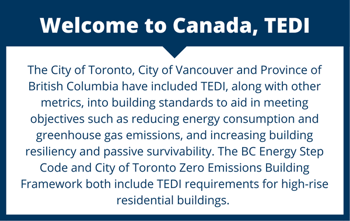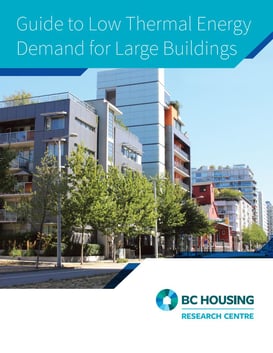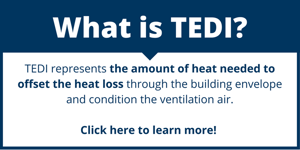How can high-rise buildings meet Net Zero ready standards? Introducing the new Guide to Low Thermal Energy Demand
Building codes and standards in Canada are becoming increasingly progressive, moving toward higher performance standards such as Passive House and Net Zero, in order to meet energy and emissions goals.
While there are many examples of Passive House or Net Zero single family homes or low-rise buildings, there is a growing interest for guidance on how to apply these standards to larger buildings. Morrison Hershfield was recently engaged by BC Housing’s Research Centre to create a guide to help fill this information gap.
The Guide to Low Thermal Energy Demand for Large Buildings aims to broaden the understanding of how high-rise residential buildings can meet the next generation of Net Zero ready standards, and build upon current design and construction practices in Canada. A new metric called Low Thermal Energy Demand Intensity (TEDI) is used to discuss viable approaches to designing and constructing Net Zero ready high-rise residential buildings.
 Minimizing the impact of thermal bridging and ventilation heat recovery are critical to Low TEDI buildings. At the moment, there is no standardization for thermal bridging calculations or testing of heat recovery ventilators (HRVs) in the context of high-rise residential buildings. To aid in the standardization and provide guidance to the industry, the Low TEDI Guide provides insight to:
Minimizing the impact of thermal bridging and ventilation heat recovery are critical to Low TEDI buildings. At the moment, there is no standardization for thermal bridging calculations or testing of heat recovery ventilators (HRVs) in the context of high-rise residential buildings. To aid in the standardization and provide guidance to the industry, the Low TEDI Guide provides insight to:
- Thermal Bridging Calculation Methodologies, including the Building Envelope Thermal Bridging (BETB) Guide, ASHRAE-1365-RP, ISO 10211, ISO 14683 and Passive House Institute (PHI).
- HRV Testing Protocols, including PHI, the Home Ventilating Institute (HVI) and the Air-Conditioning, Heating and Refrigeration Institute (AHRI).
- TEDI in the Context of Whole Building Energy, including a discussion of software implications.
- Design and Construction requirements for Low TEDI high-rise residential buildings.
 TEDI has attracted interest from policy makers in an effort to promote better building envelopes. Under current energy codes, there is room to trade-off mechanical and electrical efficiencies with lower performing envelopes. TEDI elevates the importance of the building envelope, one of the more robust energy saving measures in a building, as it is typically not prone to user or operator error, making it more likely to realize its projected energy savings.
TEDI has attracted interest from policy makers in an effort to promote better building envelopes. Under current energy codes, there is room to trade-off mechanical and electrical efficiencies with lower performing envelopes. TEDI elevates the importance of the building envelope, one of the more robust energy saving measures in a building, as it is typically not prone to user or operator error, making it more likely to realize its projected energy savings.
Want to know more about the Guide to Low Thermal Energy Demand for Large Buildings?
Keep an eye out for our next post, where we’ll provide a chapter-by-chapter summary of the guide and how it can help you with future projects.
Posts by Topic
Topics
- 5G (1)
- ACEC (3)
- Active Transportation (5)
- AFP/P3 (6)
- Alberta (5)
- Anniversary (1)
- approvals (1)
- Architect (2)
- Atlanta (2)
- Awards (62)
- Biophysical Sciences (1)
- Board of Directors (1)
- Bridge Rehabilitation (3)
- Building and Facilities Engineering (2)
- Building Energy (25)
- Building Envelope (48)
- Building Science (65)
- Calgary (2)
- Canada 150 (1)
- Canstruction (2)
- Capabilities (1)
- Carbon emissions (2)
- Carbon Pathfinder Tool (1)
- Carson Awards (5)
- Charity (13)
- Climate Adaption (7)
- climate change (7)
- Code and Life Safety (8)
- Commercial Buildings (4)
- Commissioning (11)
- Construction (2)
- Construction Administration (5)
- Consulting Engineering (1)
- Critical Facilities (33)
- CSR (24)
- Culture (5)
- Dallas (1)
- Data Center (22)
- Data Center Commissioning (9)
- Data Center Design (12)
- design (9)
- Design Build (1)
- DSSP (1)
- edgecomputing (1)
- edgetechnologies (1)
- Edmonton (4)
- Electrical (24)
- Electrical engineering (8)
- Energy (8)
- Engineers Canada (5)
- Environmental (36)
- Environmental Compensation (1)
- Environmental Impact Assessment (3)
- environmental planner (3)
- Environmental Planning (5)
- ETFE (1)
- Event (12)
- Existing Buildings (6)
- Facade Engineering (4)
- Ferry Docks (2)
- FIDIC (3)
- fisheries biologist (1)
- Flood Mapping (1)
- Florida (1)
- Forensic Investigation (1)
- Fundraising (11)
- garage (2)
- Gender Diversity (8)
- Gender Intelligence (3)
- Geometric Design (2)
- Government (14)
- Hospitality (1)
- Houston (4)
- Hydro (2)
- India (1)
- industrial (4)
- Infrastructure (28)
- Innovation (1)
- interchange (1)
- IWD (2)
- IWD2021 (1)
- Land Development (8)
- Landfill (4)
- Manitoba (1)
- MCF (3)
- Mechanical (21)
- Mechanical Engineering (1)
- MEP (1)
- mission critical (10)
- Moncton (1)
- Motivational MH'er (1)
- Multi-Use Pathways (1)
- Municipal Infrastructure (5)
- municipal solid waste (2)
- MUP (1)
- New Brunswick (1)
- New Hire (17)
- New Role (3)
- Newsroom (121)
- northern communities (2)
- NVTC (2)
- ontario (1)
- Operations Consulting (8)
- Ottawa (2)
- Panel (3)
- People (124)
- Project Management (6)
- QAP (1)
- Rail (1)
- Reconstruction (1)
- regulatory (1)
- Renewable Energy (2)
- resiliency (3)
- Risk Management (1)
- Roads and Highways (3)
- Salt Lake City (1)
- Seattle (1)
- Security (4)
- Social Responsibility (30)
- Solid Waste (11)
- solid waste management (5)
- St Johns (2)
- Stantec (1)
- Structural (14)
- Sustainability (23)
- Telecom (9)
- Texas (1)
- Toronto (13)
- towers (1)
- Traffic Assessment (2)
- Transfer Station (1)
- Transit (13)
- Transit Consultant (3)
- Transit Infrastructure (3)
- Transit Planning (2)
- Transportation (30)
- Transportation Engineering (8)
- transportation structures (2)
- TTC (1)
- Vancouver (6)
- Virginia (2)
- Washington DC (3)
- Waste to Energy (2)
- Water & Wastewater (8)
- Water Resources (3)
- wellfield (1)
- wellness challenge (1)
- Whistler (1)
- Whitehorse (1)
- Wireless (2)
- Women in Engineering (5)
- Yukon (5)

